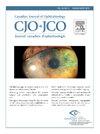新生血管性老年黄斑变性患者眼部萎缩和纤维化区域的视网膜下高反射物质。
IF 3.3
4区 医学
Q1 OPHTHALMOLOGY
Canadian journal of ophthalmology. Journal canadien d'ophtalmologie
Pub Date : 2025-02-01
DOI:10.1016/j.jcjo.2024.05.007
引用次数: 0
摘要
背景:视网膜下高反光物质(SHRM)是新生血管性年龄相关性黄斑变性(nAMD)视力不良的重要生物标志物;然而,其与纤维化和萎缩的关系还不十分清楚。本研究旨在评估接受抗血管内皮生长因子治疗的 nAMD 患者的 SHRM、萎缩和纤维化之间的关系:SEVEN-UP研究是一项多中心横断面研究,研究对象是最初加入雷尼珠单抗ANCHOR和MARINA试验的65名患者。对彩色眼底照片(CFP)进行了审查和人工分割,以确定萎缩和纤维化的区域。人工划定 OCT 容量扫描上的 SHRM 边界,计算并比较 CFP 上相应萎缩和纤维化区域的厚度测量值:在 65 名受试者中,有 51 只眼睛在 CFP 上显示出萎缩和/或纤维化,并被纳入最终分析。萎缩和纤维化区域在 OCT 上都显示出 SHRM。CFP-纤维化区域的OCT平均SHRM厚度(44.19 ± 46.95 μm)明显高于CFP-萎缩区域(14.28 ± 13.35 μm;p < 0.001)。此外,纤维化区域的 SHRM 平均最大高度(268.04 ± 130.05 μm)明显比萎缩区域(121.95 ± 51.17 μm;p < 0.001)厚:虽然萎缩和纤维化被认为是 nAMD 患者不同的终末期结果,但它们在 OCT 上都显示出 SHRM;主要区别在于厚度。鉴于这些相似之处,这些与 nAMD 相关的萎缩区域可能更适合称为 "萎缩",以将这些病变与没有新生血管疾病的典型萎缩区分开来。本文章由计算机程序翻译,如有差异,请以英文原文为准。
Subretinal hyperreflective material in regions of atrophy and fibrosis in eyes with neovascular age-related macular degeneration
Background
Subretinal hyperreflective material (SHRM) is a significant biomarker for poor visual outcomes in neovascular age-related macular degeneration (nAMD); however, its relationship with fibrosis and atrophy is not well understood. This study aims to evaluate the relationship between SHRM, atrophy, and fibrosis in eyes receiving antivascular endothelial growth factor therapy for nAMD.
Methods
Post-hoc analysis of the 65 patients enrolled in the SEVEN-UP study, a multicenter cross-sectional study of patients originally enrolled in the ANCHOR and MARINA trials of ranibizumab. Color fundus photographs (CFP) were reviewed and manually segmented to define regions of atrophy and fibrosis. SHRM borders on OCT volume scans were manually delineated, and thickness measurements were computed and compared in corresponding regions of atrophy and fibrosis on the CFPs.
Results
Of the 65 subjects, 51 eyes showed atrophy and/or fibrosis on CFP and were included in the final analysis. Both atrophy and fibrosis regions exhibited SHRM on OCT. The mean SHRM thickness on OCT was significantly greater in CFP-fibrosis regions (44.19 ± 46.95 μm) compared with CFP-atrophy regions (14.28 ± 13.35 μm; p < 0.001). Additionally, the average maximum height of SHRM in fibrotic regions (268.04 ± 130.05 μm) was significantly thicker than in atrophic regions (121.95 ± 51.17 μm; p < 0.001).
Conclusions
Although atrophy and fibrosis are thought to be different end-stage outcomes in eyes with nAMD, they both demonstrate SHRM on OCT; the main distinction being thickness. Given these similarities, these regions of nAMD-associated atrophy may be better-termed “atrosis” to distinguish these lesions from typical atrophy in the absence of neovascular disease.
Contexte
Le matériel hyperréflectif sous-rétinien (SHRM, pour subretinal hyperreflective material) est un biomarqueur significatif de résultats visuels médiocres dans la dégénérescence maculaire liée à l’âge néovasculaire (DMLAn); cependant, on connaît mal son lien avec la fibrose et l'atrophie. Notre étude se penchait donc sur l'association entre le SHRM, l'atrophie et la fibrose dans des yeux traités par anti-VEGF (facteur de croissance endothélial vasculaire) en raison d'une DMLAn.
Méthodes
Il s'agissait d'une analyse a posteriori de 65 patients admis à l’étude SEVEN-UP (étude transversale multicentrique portant sur les patients admis aux études ANCHOR et MARINA sur le ranibizumab). On a examiné les photographies en couleurs du fond d’œil (PCFO) pour ensuite les segmenter manuellement afin de cerner les zones d'atrophie et de fibrose. Les bordures du SHRM sur les images de volume obtenues à la tomographie par cohérence optique (OCT) ont été délimitées à la main, et les mesures de l’épaisseur ont été calculées et comparées à celles des zones d'atrophie et de fibrose correspondantes sur les PCFO.
Résultats
Les PCFO de 51 yeux (65 sujets) faisaient ressortir une atrophie et/ou une fibrose; ces derniers ont été inclus dans l'analyse finale. On a noté la présence de SHRM dans les zones d'atrophie et de fibrose sur les images OCT. L’épaisseur moyenne du SHRM sur les images OCT était significativement plus élevée dans les zones de fibrose sur les PCFO (44,19 ± 46,95 μm), comparativement aux zones d'atrophie sur les PCFO (14,28 ± 13,35 μm; p < 0,001). De plus, l’épaisseur maximale moyenne du SHRM était significativement plus importante dans les zones de fibrose (268,04 ± 130,05 μm) que dans les zones d'atrophie (121,95 ± 51,17 μm; p < 0,001).
Conclusions
Bien que l'atrophie et la fibrose soient perçues comme des manifestations de phase terminale différentes dans la DMLAn, elles laissent toutes deux paraître du SHRM à l'OCT, la différence principale tenant à l’épaisseur. Compte tenu de telles similitudes, ces zones d'atrophie associées à la DMLAn devraient plutôt être appelées « atrose » pour distinguer ces lésions de l'atrophie typique en l'absence de pathologie néovasculaire.
求助全文
通过发布文献求助,成功后即可免费获取论文全文。
去求助
来源期刊
CiteScore
3.20
自引率
4.80%
发文量
223
审稿时长
38 days
期刊介绍:
Official journal of the Canadian Ophthalmological Society.
The Canadian Journal of Ophthalmology (CJO) is the official journal of the Canadian Ophthalmological Society and is committed to timely publication of original, peer-reviewed ophthalmology and vision science articles.

 求助内容:
求助内容: 应助结果提醒方式:
应助结果提醒方式:


